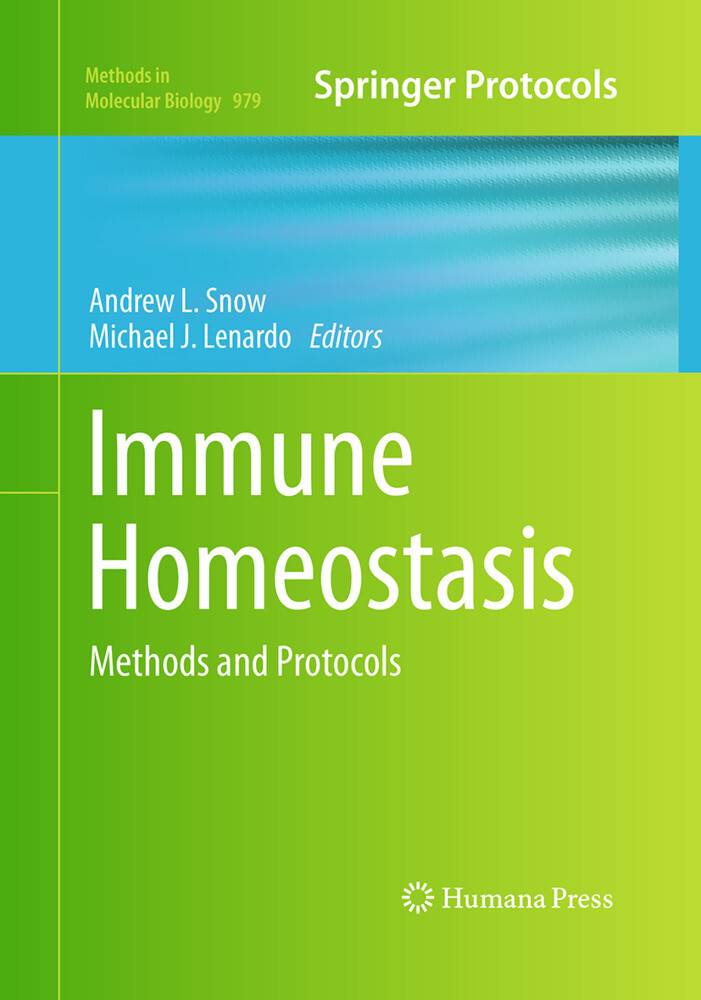
Zustellung: Sa, 18.01. - Di, 21.01.
Versand in 2 Tagen
VersandkostenfreiBestellen & in Filiale abholen:
This book examines experimental techniques for measuring and analyzing immune cell dynamics, with an emphasizes lymphocyte programmed cell deaths in different contexts. It features expert tips and key implementation advice to guarantee successful results.
Many questions remain unresolved as researchers continue to characterize and define the nature of normal immune homeostasis and determine how these processes are dysregulated in immunodeficiency, as well as in autoimmune and lymphoproliferative disorders. Immune Homeostasis: Methods and Protocols focuses on experimental techniques for measuring and analyzing immune cell dynamics, with a particular emphasis on examining lymphocyte programmed cell death in different contexts. With contributions by leading experts in the field, the collection examines detailed protocols for studying various pathways of apoptosis and necrosis in different types of hematopoietic cells, both in vitro and in vivo, methods for studying the maintenance of lymphocyte populations in the steady-state or following infectious challenges in both mice and humans, and technical insights into state-of-the-art genomics tools, among other topics. Written in the highly successful Methods in Molecular Biology(TM) series format, chapters include introductions to their respective topics, lists of the necessary materials and reagents, step-by-step, readily reproducible laboratory protocols, and tips on troubleshooting and avoiding known pitfalls.
Valuable and easy to use, Immune Homeostasis: Methods and Protocols serves as an important toolkit for basic and clinical scientists interested in examining various aspects of immune homeostasis in both normal and disease-related contexts in order to further study the dynamic processes that contribute to homeostasis of the immune system.
Inhaltsverzeichnis
Quantitating Lymphocyte Programmed Cell Death (PCD) In Vitro Using Simple Kill Assays. - Fluoresence-Activated Cell Sorting (FACS)-Based Quantitation of T Cell Receptor Restimulation-Induced Cell Death (RICD) in Activated, Primary Human T Cells. - Evaluation of IL-2-Withdrawal Induced Apoptosis in Human T Lymphocytes. - Determination of Apoptosis Sensitivity in Specific T Cell Subsets from Human Peripheral Blood by Utilizing a Multi-Parameter Fluorescence Activated Cell Sorting (FACS)-Based Technique. - Visualization of Fas-Mediated Death-Inducing Signaling Complex (DISC) Formation by Immunoprecipitation. - Analyses of Programmed Cell Death in Dendritic Cells. - Detection of Necrosis by Release of Lactate Dehydrogenase (LDH) Activity. - Assessment of CD4
+
and CD8
+
T Cell Responses Using MHC Class I & II Tetramers. - Homeostatic Proliferation of Mature T Cells. - Quantitating Lymphocyte Homeostasis In Vivo in Humans Using Stable Isotope Tracers. - Real-Time Quantitative (RQ-)PCR Approach to Quantify the Contribution of Proliferation to B Lymphocyte Homeostasis. - Molecular Measurement of T Cell Receptor Excision Circles. - Isolation of RNA and the Synthesis and Amplification of cDNA from Antigen-Specific T Cells for Genome-Wide Expression Analysis. - Designs for Massively Parallel Sequencing Approaches to Identify Causal Mutations in Human Immune Disorders. - Flow Cytometric Measurement of SLAM-Associated Protein (SAP) and X-Linked Inhibitor of Apoptosis (XIAP). - In Vitro Suppression Assay for Functional Assessment of Human Regulatory T Cells.
Produktdetails
Erscheinungsdatum
23. August 2016
Sprache
englisch
Auflage
Softcover reprint of the original 1st ed. 2013
Seitenanzahl
228
Reihe
Methods in Molecular Biology
Herausgegeben von
Michael J. Lenardo, Andrew L. Snow
Verlag/Hersteller
Produktart
kartoniert
Abbildungen
XI, 215 p.
Gewicht
438 g
Größe (L/B/H)
254/178/13 mm
Sonstiges
Paperback
ISBN
9781493959686
Entdecken Sie mehr
Bewertungen
0 Bewertungen
Es wurden noch keine Bewertungen abgegeben. Schreiben Sie die erste Bewertung zu "Immune Homeostasis" und helfen Sie damit anderen bei der Kaufentscheidung.










